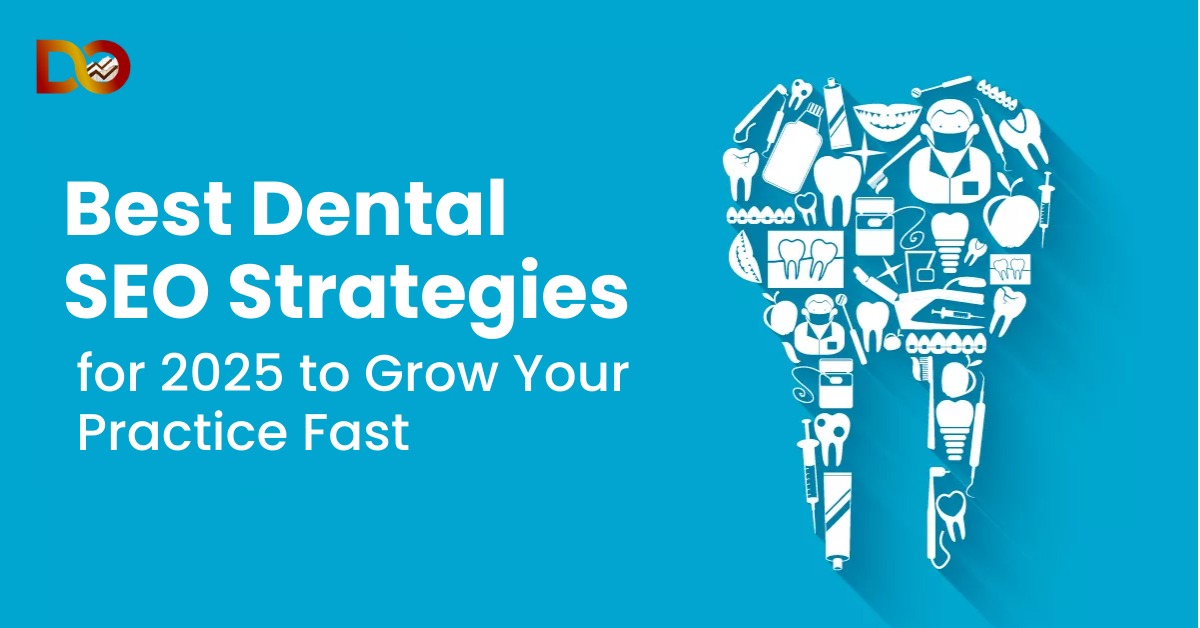In 2025, the search for dentists is changing fast. Google’s new AI-powered search features can answer patient questions immediately, and voice assistants like Siri and Alexa deliver answers, making conversational queries the norm. At the same time, Google’s updates reward helpful, human-centered content and trust signals like positive reviews. To grow your practice fast, you must update your SEO strategy now to the best dental SEO strategies.
As digital competition intensifies across the medical field, dentists aren’t the only ones stepping up their game. Broader SEO for Healthcare and Wellness is becoming crucial for clinics, wellness centers, and private practitioners aiming to attract local patients and rank well on Google. Dental SEO is just one part of this larger transformation.
As the majority of patients now use search engines to find local services, appearing at the top of Google can dramatically increase new patient leads. In healthcare, trust is critical; SEO is how you build trust online by demonstrating your expertise and experience. Key factors like page experience and content quality are now central to Google’s algorithms, meaning your website must deliver valuable, accurate information just as you do in your office.
Key trends and strategies for best dental SEO in 2025 include:
- AI-Powered Search (SGE and GEO): Optimize content for Google’s Search Generative Experience and AI assistants.
- Voice and Conversational Search: Use natural, conversational keywords and question phrases to match voice queries.
- Content Quality and E-E-A-T: Focus on patient-first, expert content that demonstrates Experience, Expertise, Authoritativeness, and Trust.
- Mobile-First Design: Ensure a fast, mobile-friendly website – Google primarily uses the mobile site for ranking.
- Local SEO and Reviews: Update your Google Business Profile, gather positive patient reviews, and use local schema markup.
Embrace AI-Driven Search (SGE and GEO)
Google is moving toward AI-powered answers. SGE (Search Generative Experience) is Google’s new AI layer on search. When a patient asks a question, SGE can summarize multiple web pages into one answer. For example, if someone asks “How often should I get a dental cleaning?”, Google might display a concise list of best practices right away. If your site provides that information, it could be highlighted. This changes SEO: instead of just ranking pages, you’re giving Google answers it can relay directly to searchers.To stay ahead, the best dental SEO now focuses on optimizing for these AI-powered results.
Google’s SGE and other AI tools like ChatGPT can directly answer patient questions using information from various websites. For example, instead of listing practice websites, an AI assistant might say: “Dr. [Name] at [Practice Name] is available now, has five-star reviews, and accepts walk-ins.”. This means your content must be written for AI consumption. A strategy called Generative Engine Optimization (GEO) focuses on making content easily usable by AI search. In practice, write clear answers to common patient questions, use a conversational tone, and structure content in FAQ or list formats so AI can parse it. Include relevant images or short videos too – Google may show visuals in its AI results for dental procedures.
Don’t worry if AI answers reduce some click traffic. If AI snippets fully answer basic questions, the visitors who do click through will likely be highly interested and ready to book an appointment.
Optimize for AI search:
- Use schema markup (FAQ, How-To) so Google’s AI can find and highlight your answers.
- Target long-tail, conversational queries (e.g. “best dentist near me for braces”) instead of generic keywords.
- Create expert, in-depth content on key dental topics to boost your authority and EEAT score.
Optimize for Voice and Conversational Search
Voice search is going mainstream, and with it comes a unique opportunity to optimize for the best dental website SEO. Patients often ask full questions to assistants like Siri or Alexa on their phones. To capture this traffic, make your content answer questions in everyday language.
For example, include FAQ sections or blog posts written as full answers. Use long-tail question keywords. Instead of just “dentist Birmingham,” add content that answers a question like “Who is the best dentist near me in Birmingham?”. Make sure you address common patient questions clearly on your site. This also helps with featured snippets, which voice assistants often use to speak answers aloud.
Because voice search is usually mobile, these tips also improve your mobile SEO. Speaking naturally means using simpler words and shorter sentences. Structure pages with clear headers and bullet lists so an assistant can find quick answers. Voice queries have grown with smartphone and smart speaker use. Many patients ask questions while cooking or driving. For example, someone might say, “Find an emergency dentist open now,” and expect an immediate recommendation. If your website answers a question like “What to do during a dental emergency?”, you’re more likely to be featured.
Voice SEO Tips:
- Write in a conversational tone, as if talking to a patient.
- Use question phrasing and natural language keywords (e.g. “Who’s the best dentist near me?”).
- Add FAQ or Q&A content to cover common patient queries.
- Include local terms (“near me,” city names) to capture location-based voice queries.
Focus on Content Quality and E-E-A-T
In 2025, content is still king, but Google rewards high-quality, human-first content. Generic pages stuffed with keywords won’t cut it. Write content with real purpose: explain procedures, answer patient questions, and share your practice’s unique expertise.The best dental SEO strategies prioritize this kind of valuable, experience-driven content to earn trust and visibility.
Google expects healthcare content to show E-E-A-T (Experience, Expertise, Authoritativeness, Trustworthiness). Demonstrate this by showcasing your credentials and experience. Include detailed dentist bios with qualifications and certifications. Link to reputable sources (like dental associations or medical publications) and include patient testimonials or case studies to show real results. Keeping blog posts and FAQs up to date also strengthens EEAT by showing your ongoing involvement and real-world expertise.
In healthcare, providing truly helpful content is both ethical and strategic. Write posts that genuinely help patients. For example, explain “How to brush and floss properly”, “What to expect during a root canal”, or “Tips for managing dental anxiety.” Google’s Helpful Content Update rewards sites that fully answer patient questions. Use clear, simple language: define any technical terms in plain English. Include images or diagrams (with keyword-rich alt text) to illustrate procedures or oral anatomy. This helps users understand and gives Google more context. For more complex topics, consider adding infographics or short videos. The more value you provide, the more Google will see your site as an authoritative resource.
Don’t forget on-page SEO basics: use target keywords naturally in your titles, headings, and first paragraph, but always write for people first. For example, a title like “Family Dentist in Miami – Gentle Care for Your Smile” uses keywords but reads smoothly. Craft unique meta descriptions with those keywords to summarize the page’s content. Use internal links to related pages (for example, link a blog post to your appointment or contact page) to help visitors and search engines navigate your site.
By focusing on helpful, detailed content and proving your authority, you signal to Google that your site is a trusted resource – which boosts your rankings.
Strengthen Local SEO and Manage Reviews
Local SEO for dentists is crucial. Most patient searches include a location or “near me,” so you want to be in Google’s Local Pack (the map and top business list). Claim and optimize your Google Business Profile first. Make sure your practice’s name, address, and phone (NAP) are correct and consistent across the web. Complete your profile with accurate hours, photos, and a full list of services. Incorporating these steps is essential for the best dental SEO, helping your practice stand out in local, high-intent searches.
Encourage patients to leave Google reviews. Positive reviews not only build trust with potential patients but also boost your local rankings. Always respond to reviews – whether they’re praise or criticism – to show that you care. Google sees this engagement as a trust signal, part of your EEAT profile.
Use local schema markup to help search engines. For example, add LocalBusiness or Dentist schema with your address and specialties. Also, consider adding FAQ or Service schema on Q&A pages. Schema makes it easier for Google to display your info in rich results and knowledge panels, especially for zero-click searches.
Local SEO for dentists Tips:
- Use consistent NAP (Name, Address, Phone) on your website and directory listings.
- Include location keywords (city, neighborhood) in your site content.
- List key services (like “emergency dentist” or “teeth whitening”) on your website and Google Profile.
- Keep your Google Business Profile updated and post regularly (updates, offers, photos).
- Use schema markup for your business location and services.
Additionally, think local: create content about your community. For example, write “Dental health tips for [Your City] residents” or blog about a local event your practice sponsored. Getting mentions or links from local news sites or community blogs can significantly boost local SEO for dentists. If you have multiple offices, make separate pages for each location with customized info (hours, staff, directions) and ensure all your listings remain consistent.
Improve Technical SEO dentists and Site Performance
Don’t overlook the technical side. Google now considers page experience a ranking factor. This includes site speed, mobile-friendliness, and overall usability. A fast, well-designed site keeps visitors happy and ranks higher. These technical improvements are foundational to the best dental SEO, ensuring both users and search engines have a seamless experience.
Make sure your site loads quickly. Compress images, minify code, and use caching. Tools like Google’s PageSpeed Insights or Lighthouse can pinpoint slow elements. Aim for Largest Contentful Paint (LCP) under 2.5 seconds and minimal layout shifts (low CLS). Use a Content Delivery Network (CDN) to serve your files faster across regions.
Ensure your site is mobile-responsive and secure (HTTPS). With mobile-first indexing, Google primarily uses the mobile version of your site for rankings. If your site isn’t optimized for phones, fix it now. Also, enable an SSL certificate (HTTPS) so the connection is secure – browsers and Google favor secure sites.
Check for broken links or missing pages. Use an SEO audit tool to find 404 errors, then set up 301 redirects to relevant pages. This prevents lost traffic and ensures Google can crawl all your content. Create an XML sitemap and submit it to Google Search Console to help Google discover new pages. Use a clear site structure (breadcrumb navigation) so both users and search engines understand your content hierarchy.
For example, fix any 404 errors and use redirects so neither visitors nor Google’s crawlers hit a dead end. Implement breadcrumb schema (BreadcrumbList) so Google can show your page path in results. These technical fixes ensure that all your optimization efforts have a solid foundation.
Beyond SEO, building a seamless patient experience online matters. That’s where web portal development services come in — helping dental clinics create secure, user-friendly platforms where patients can book appointments, access records, and engage with services easily.
Track and Refine Your Strategy
SEO dentists is a long-term process, so track your results. For instance, Google Analytics shows how many visitors come from search, which pages they visit, and how long they stay. Google Search Console reveals which keywords you rank for, how often your pages appear, and any site issues. These tools show what’s working and what’s not.Ongoing analysis and refinement are what set the best dental SEO strategies apart, ensuring your efforts lead to consistent growth.
Monitor metrics like organic traffic, bounce rate, and conversions (appointment requests or calls). If one page is attracting a lot of visitors, update it regularly and consider promoting it. If a keyword has high impressions but few clicks, improve that page’s title or content to entice searches. Check your rankings for key terms periodically. This data-driven approach lets you refine your strategy over time.
By tracking performance and adapting your approach, you ensure continued growth. SEO for dentists gains momentum: the more you refine based on data, the stronger your results.
Conclusion: Invest in SEO dentist to Grow Your Practice
For dentists, SEO in 2025 is essential. AI-powered search and voice assistants mean patients get instant answers – only practices with optimized content will appear. Google also rewards sites that demonstrate real expertise, experience, and trust. Investing in best dental SEO today means your practice will rank higher, attract more local patients, and build credibility.
Think long-term: SEO services for dentists build a foundation of steady visibility. Even if referrals or ads fluctuate, ranking highly on Google brings consistent organic traffic. The sooner you start, the faster you build that pipeline of new patients. Don’t let competitors take your audience – act now to become your community’s top dental practice.
Schedule an SEO audit or contact a digital marketing specialist who understands dentistry and the best SEO for dentists. The investment you make in SEO today will pay off with more growth tomorrow.
Get started now to secure your practice’s success in 2025!
FAQ (2025 Best Dental SEO)
- What is SEO for dentists and why is it important in 2025?
SEO for dentists is optimizing your practice’s online presence so Google ranks it highly. In 2025, nearly all patients start with an online search for a dentist. Appearing at the top of Google results means more clicks and more new appointments. It also means your website will be visible in rich results (like maps and snippets) that many patients use.
- How does Google’s AI-driven search (SGE) affect my dental practice’s SEO?
Google’s AI search (SGE) provides instant answers on the results page. For example, if someone asks “How can I stop tooth pain?”, Google might show a summarized answer from multiple sites. This can satisfy a query without any click. To stay visible, structure your website to answer common questions directly. Use FAQ or Q&A formats and add schema markup so Google’s AI can pull answers from your content. That way, even if Google shows an answer, it will be based on your site’s information.
- What does E-E-A-T mean and why should I care?
E-E-A-T stands for Experience, Expertise, Authoritativeness, and Trustworthiness. Google uses these factors to judge content quality, especially for health topics. To improve E-E-A-T, clearly display your expertise: add dentist bios with qualifications and explain your experience. Cite trustworthy sources. Also, collect patient reviews and gain links from reputable sites. Showing you are an expert with real experience and patient trust helps Google rank your content higher.
- Do people really use voice search for dentistry?
Absolutely. Many voice queries are local (like “dentist near me open now”). Dentists should use conversational phrasing and full questions as keywords. For example, include content that answers “Who is the best family dentist near me?”. This way, when someone asks a voice assistant, your content can be the answer. Remember, voice search often picks the featured snippet or quick answer, so optimize for those.
- How can I improve my local search presence?
Start with your Google Business Profile. List your exact name, address, and phone (NAP) consistently. Add your hours, services, and photos. Encourage patients to leave Google reviews – more positive reviews boost your local ranking and build trust. Use location-specific keywords on your site (like your city or neighborhood), and implement local schema (like LocalBusiness) so Google clearly links your website to your location. These steps help your practice appear in local searches and the map.







